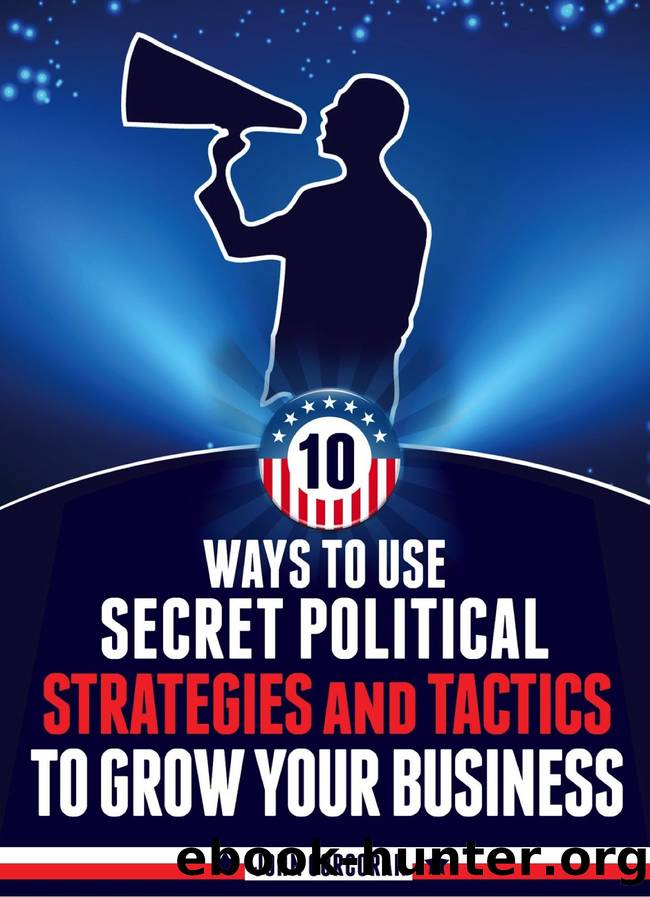The Political Entrepreneur: How to Use Secret Political Strategies and Tactics to Grow Your Business by Corcoran John

Author:Corcoran, John [Corcoran, John]
Language: eng
Format: epub
Published: 2018-09-15T16:00:00+00:00
Learn As Much About Your Ideal Supporters As Possible
Chris Cassidy had no business being in South Dakota.
A self-described progressive, Cassidy had recently moved to the heart of the conservative midwest from San Francisco, the heart of liberalism.
Like so many political staffers, Cassidy had relocated for a job, and one which would be a few month whirlwind climaxing on general election day 2008. The job was his big break - communications director for an effort to defeat a ballot initiative designed to ban so-called âpartial-birth abortionâ in almost all instances in South Dakota.
Those pushing the measure were a collective of conservative groups deeply ingrained in the South Dakota community.
On Cassidyâs side was Planned Parenthood, an organization that was extremely unpopular in the more conservative reaches of the state.
It was an uphill battle. And one which they were destined to lose.
â South Dakota was solidly Republican. The state had voted for the Republican candidate in Presidential elections going back at least 30 years.
But a funny thing happened on the way to the ballot box. Cassidy and the campaign team took the time at the outset to find out if there was any chance their side could prevail. And they found there was daylight if they used the right language to describe the choice voters would be making.
The campaign team threw out earlier messaging in similar campaigns which had fallen into the well-worn âchoiceâ vs. âlifeâ framework which traditionally defined abortion debates. Instead, the team described the blanket ballot initiative as big government imposing its will on women and families - a message which resonated with the more libertarian-leaning elements of the stateâs electorate.
âThe message broke down political barriers,â said Cassidy. âWe were honest in every respect but itâs just a matter of choosing the terms people would be most receptive to.â
Cassidyâs side ended up winning - pulling off an improbable upset on the same day that Barack Obama lost South Dakota to Senator John McCain by almost 10 points. The messaging worked for the campaign because they took the time to understand their audience and tailor their messaging to that audience.
One of the first things any campaign manager or candidate does at the outset of a campaign is they march down to the local registrarâs office or clerkâs office and get a copy of the voter list. Campaigns donât based their outreach to voters on hunches or intuition - they base their outreach on cold hard facts.
Many businesses do not identify their ideal market with such precision, especially when they are small or just starting out. Often businesses will take a âanyone is welcomeâ approach - ensuring they will appeal to no one.
â Based on voter data and polling, campaigns will hone in on their ideal voter demographic. For example, a campaign may decide that soccer Moms between the age of 35 and 45 from families earning over $120,000 per year is their ideal voter.
That knowledge is huge. The campaign can then target its messaging toward that ideal voter. The campaign will pick events that appeal to that voter.
Download
This site does not store any files on its server. We only index and link to content provided by other sites. Please contact the content providers to delete copyright contents if any and email us, we'll remove relevant links or contents immediately.
| Consulting | Entrepreneurship |
| Franchises | Home Based |
| Marketing | New Business Enterprises |
| Nonprofit Organizations & Charities |
Pioneering Portfolio Management by David F. Swensen(5598)
Zero to One by Peter Thiel(4816)
Man-made Catastrophes and Risk Information Concealment by Dmitry Chernov & Didier Sornette(4728)
The Motivation Myth by Jeff Haden(4521)
The Miracle Morning by Hal Elrod(3903)
Elon Musk by Ashlee Vance(3446)
The Art of Persistence: Stop Quitting, Ignore Shiny Objects and Climb Your Way to Success by Michal Stawicki(3365)
Unlabel: Selling You Without Selling Out by Marc Ecko(2974)
Urban Outlaw by Magnus Walker(2945)
Delivering Happiness by Tony Hsieh(2917)
Purple Cow by Seth Godin(2692)
Mastering Bitcoin: Programming the Open Blockchain by Andreas M. Antonopoulos(2504)
The Content Trap by Bharat Anand(2488)
The Marketing Plan Handbook: Develop Big-Picture Marketing Plans for Pennies on the Dollar by Robert W. Bly(2407)
The Power of Broke by Daymond John(2373)
The Airbnb Story by Leigh Gallagher(2363)
Applied Empathy by Michael Ventura(2322)
Radical Candor by Kim Scott(2209)
Keep Going by Austin Kleon(2154)
